Are you starting to notice discoloration and corrosion on your hot tub shell? If your answer is yes, then that means there is something wrong with the pH level in your hot tub water.
When the pH level in your hot tub water is off, you will start to notice discoloration and corrosion of the hot tub shell, staining on the hot tub frame, scale build-up on the filters, dry skin, and so much more. Not only is the wrong pH level bad for your hot tub, but it’s also bad for your health too.
There are a few things that could be affecting the pH level in your hot tub. Today, we are going to discuss the top 6 common things that could be affecting your hot tub’s pH level, what they are, and how to fix them. So, let’s get on with it.
Does Chlorine Raise or Lower pH in a Hot Tub?
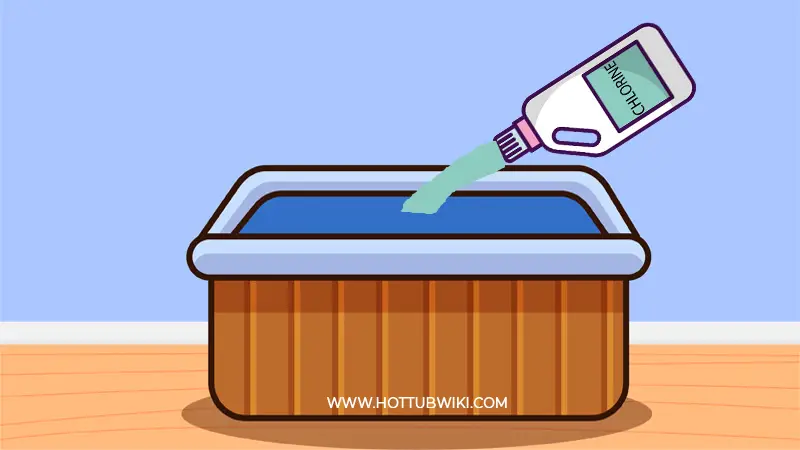
Chlorine lowers the pH level in your hot tub but it doesn’t lower it to a level that would damage the hot tub unless you add a heavy dose of chlorine to the water.
When you add chlorine to your hot tub water, hypochlorous acid which is a weak acid is released into the water. The hypochlorous acid that is produced cleans and disinfect the water by killing bacteria and getting rid of hot tub scum.
This acid lowers the pH level in the water because chlorine works better in slightly acidic water. However, it doesn’t lower the pH to a level that would harm you or the hot tub. It only lowers the pH level a bit so the chlorine you added can work better.
So while chlorine will lower the pH level, the drop in the pH level is not enough to cause harm. It will only cause harm if you add too much chlorine to the water. This is why it’s always advised not to use your hot tub after shocking it or after adding a high dose of chlorine to the water.
Related Read >>> Can You Use a Hot Tub if the pH Level is High?
How to Deal With Too Much Chlorine
If you accidentally added too much chlorine to the water in your hot tub, here is how to deal with it.
You should first test the water to be sure the pH level has been altered below the recommended level. The right pH level for hot tubs is between 7.2 and 7.8 on the pH scale. If the pH level is below 7.2, that means you already added too much chlorine and now the pH level is too low.
The next thing to do is to vacate the hot tub. Then leave the hot tub cover off and turn on the jets. You should also leave the heater on so the water is being heated.
As the water is being heated, the excess chlorine is being evaporated with the water vapor and it can escape since you left the hot tub cover off. You can also add fresh water to the hot tub so the remaining chlorine is diluted. This will reduce the chlorine levels and also raise the pH to the needed level.
Does Vinegar Lower the pH in a Hot Tub?
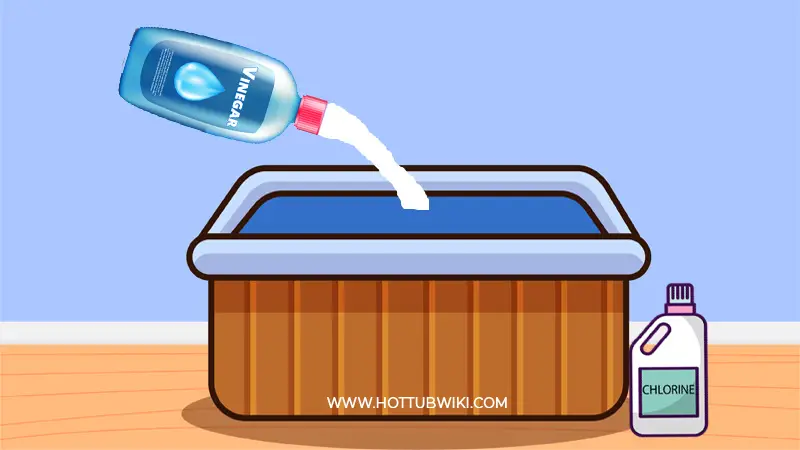
Vinegar is an acid that will only lower the pH level in your hot tub if a very high amount is added or if a very strong type of vinegar like the spirit vinegar is added to the water. Vinegar is a weak acid that is used as a cleaning agent. White vinegar especially is used to clean hot tubs. The acidic content of vinegar however is not enough to lower the pH in your hot tub to a level that will cause concerns.
Asides from being a weak acid, the acidic content of vinegar is also reduced when it is mixed with water. So if you mix vinegar and water, the acidic level of the vinegar will drop.
The more water you add to vinegar, the lower the acidic content. Even if you add some vinegar to your hot tub, the water in the hot tub will be too much for the vinegar to even have any effect on the pH level of the water.
That being said, you can use vinegar in and around your hot tub without any fear or concern. Vinegar disinfects, cleans, and some products have nice fragrances too. Vinegar wouldn’t lower your hot tub’s pH unless you add a very high amount to the water. But what if you do?
How to Deal With Too Much Vinegar?
If you suspect there is too much vinegar in your hot tub water, the first thing to do is to test the water to be sure. If the results show that the pH level of the water has been lowered, then that means you have added too much vinegar.
The next thing to do is to dilute the water. To do this, drain a bit of the water in the hot tub and refill it. Then test the water to check if the pH level has been raised to the needed level (between 7.2 and 7.8 on the pH scale).
Related Read >>> Can You Use Vinegar in a Hot Tub?
Will Shocking a Hot Tub Lower the pH Level?
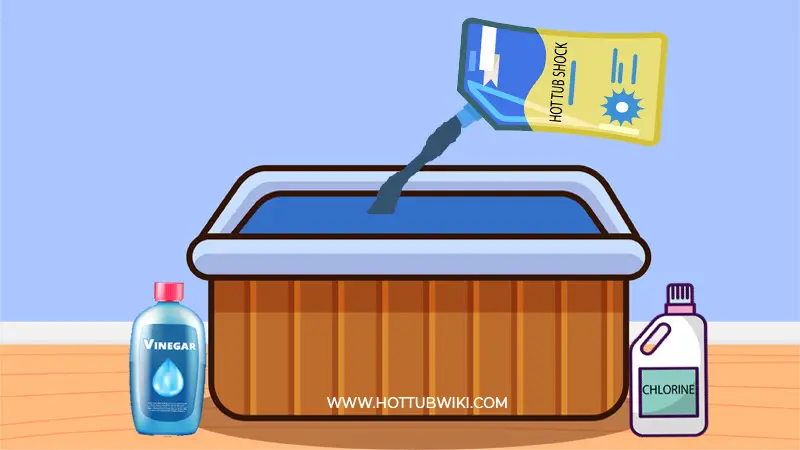
Yes, shocking your hot tub will lower the pH level of the water. When you shock the water in your hot tub, you directly add a very high dose of sanitizer, usually chlorine into the water. Since chlorine works best in low pH water, the shock you added will lower the water pH drastically so the chlorine can battle and kill any bacteria in the water.
This is why you should always test the pH level of the water before you shock it. If you add chlorine shock to water that already has a low pH reading, it can cause corrosion and staining.
Also, if you shock water that has a very high pH reading, it can cause foaming and cloudy water. If there is anything that can cause a drop in the pH level of your hot tub, it is shocking the water.
How to Deal With Too Much Hot Tub Shock
The best way to deal with too much shock is not to add too much shock. Yes, you read that correctly. But if you accidentally added too much shock, first test the water using test strips to be sure the pH level is below 7.2 on the pH scale.
The next thing to do is to give the hot tub time. Vacate the hot tub for a while to allow the pH level to rise again. The good thing here is hot tub shock is usually used up over time.
So if you give the hot tub time, the shock will be gradually reduced till it gets to a level when you can use it again. As usual, always test the pH level of the water to be sure.
Does Bromine Affect pH in a Hot Tub?
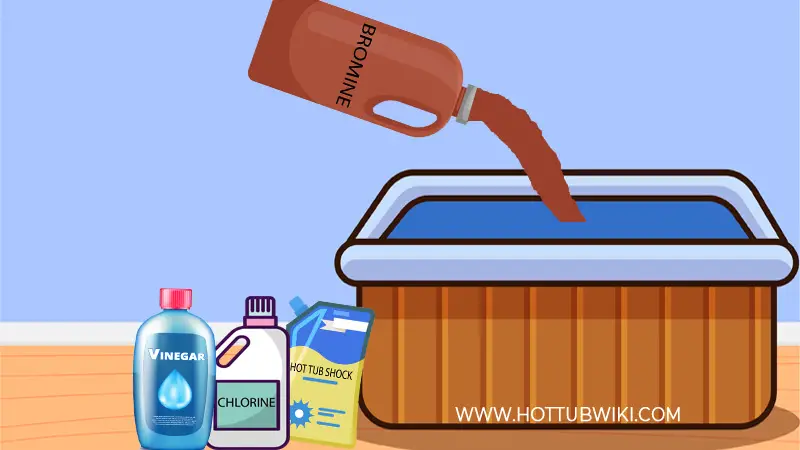
Bromine affects the pH level in a hot tub by lowering the alkaline levels. Bromine is a sanitizer and it also has its fair share of acidic content which helps it to fight bacteria and keep the water clean. Bromine will gradually reduce the pH and alkaline levels of the hot tub over time.
Bromine just like chlorine is used to sanitize hot tub water. This means bromine will also reduce the pH levels in your hot tub. But the good news is bromine is not as potent as chlorine. Though bromine will lower the pH level of the water, it wouldn’t do so until the water has an over-concentration of bromamines and this will take a while.
So just like I mentioned with chlorine, bromine wouldn’t lower the pH of your hot tub to a level that will cause health concerns or damage your hot tub unless you are very careless with the sanitizer.
How to Cope With Too Much Bromine
If you added too much bromine to the water, test the pH level of the water first. Chances are the pH level would still be within the 7.2 and 7.8 range since it takes a while and a high amount of bromine to change the water pH.
However, if the pH level is below 7.2, then you should add a base chemical or baking soda to the water to raise the pH level to the recommended level.
Will Baking Soda Lower the pH Level in a Hot Tub?
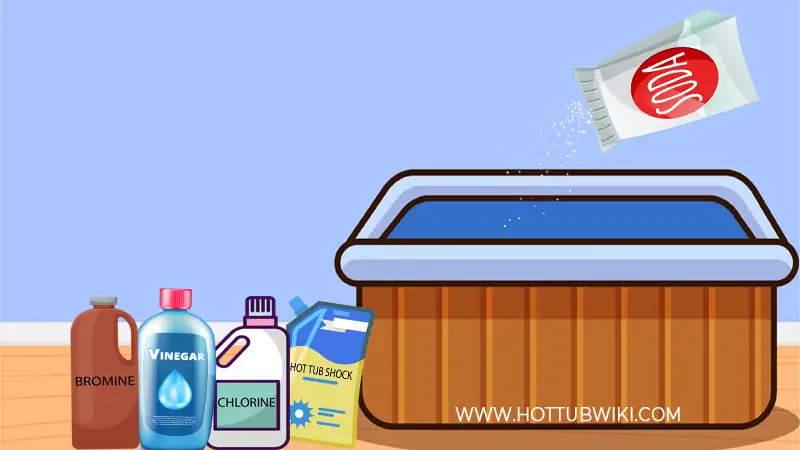
No, baking soda will not lower the pH level in your hot tub water because baking soda is an alkaline substance. This means it doesn’t lower pH levels. Instead, it raises the pH level of the water. Baking soda will not make the water in your hot tub acidic by lowering the pH, it will instead make the water more alkaline by increasing the pH level of the water.
Baking soda is categorized as an alkaline substance. When mixed with water, baking soda produces a base or alkaline solution that raises water pH rather than drop it. So your baking soda will in no way make the water more acidic.
This doesn’t however mean that you can just add baking soda to the hot tub water. Remember that the right pH range for a hot tub is between 7.2 and 7.8 on the pH scale. Baking soda can very much raise your water pH level above the 7.8 range.
When this happens, you wouldn’t notice staining or corrosion as you would with acidic water. Instead, the water will become unclear, cloudy, and foam will start to appear in the water. Not to mention the fact that your hot tub will have a serious case of scale.
So if you are to add baking soda in a hot tub, follow the instructions or add a tablespoon of baking soda to every 100 gallons of water. So if you have a 600-gallon hot tub, add 6 tablespoons of baking soda.
How to Deal With Too Much Baking Soda
If you added too much banking soda to the water, you can resolve the problem in two ways. First, you can drain a bit of the water and then refill it. This will dilute the baking soda remaining in the water.
Secondly, you can add an acidic substance to the water. This includes chlorine, diluted bleach, or hot tub shock. Any of these methods will resolve the problem.
Does Increasing Alkalinity Increase pH?
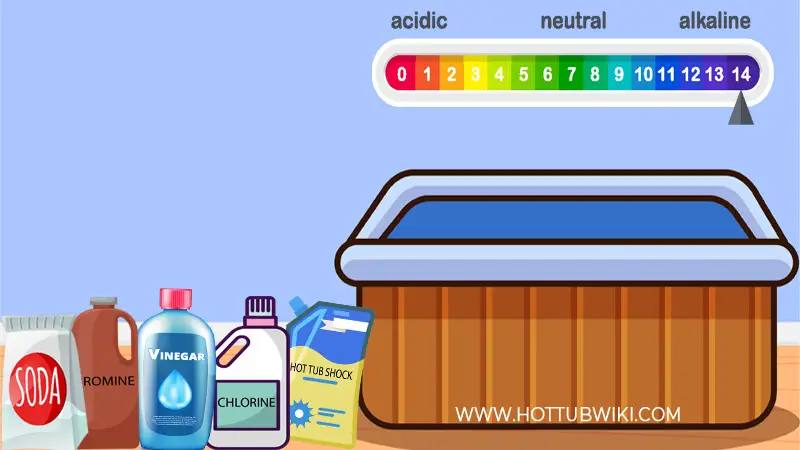
To a large extent, it does. When you increase the alkalinity of hot tub water, you also increase the pH of the water. But sometimes, it’s possible to have a low pH level and a high alkaline level in the hot tub.
The pH scale is measured from 0 – 14. 0-6 is considered to be acidic. 7 is considered to be neutral while 8-14 is considered to be alkaline. So if you increase alkalinity, this means you are raising the pH level of the water. For instance, let’s assume the pH level in your hot tub is 6. This means the pH level is slightly acidic.
If you add baking soda to the water or any other base solution, the solution will increase the pH level. If the pH level is increased from 6 to 8, this means you have raised the pH level while also increasing the alkalinity of the water. I’m sure you get it now. So how do you deal with too much alkalinity in the hot tub water?
How to Deal With Too Much Alkalinity
The best way to deal with too much alkalinity is to drop the alkaline level of the water by adding an acidic substance to the water.
You can also shock the hot tub water by adding chlorine shock and you can add other acidic substances like bleach or vinegar to the water to drop the pH level from an alkaline level to the recommended level.
Related Read >>> How To Lower Alkalinity Levels in a Hot Tub?
What Else Affects the pH Level in the Hot Tub Water
Virtually everything you add to the hot tub water affects the pH level in one way or the other. Even you affect your hot tub’s pH level every time you soak in it. When you soak in the water, the bodily fluids from your body, the skin cells, body oils, sweat, and the likes can lower the pH level of the water.
In addition to that, many of the so-called hot tub cleaning products can also affect the pH of the water. Food and drink reside like soda can also affect your hot tub’s pH level.
So, you should be mindful of the products you put in your hot tub and you should always keep tabs on the pH level of the water by testing it regularly.
Final Words
Overall, maintaining the pH level in your hot tub water is crucial to having healthy water in the hot tub. If the pH ever falls above or below the recommended level, you shouldn’t take a soak in the water.
Instead, ensure to fix the pH level first to ensure the water is safe for soaking in. You should also test the pH level of the water before and after you add any substance or chemical to the water. This will indicate any spike or drop in the pH level of the water.
